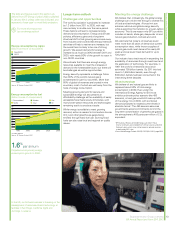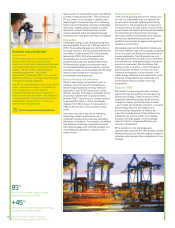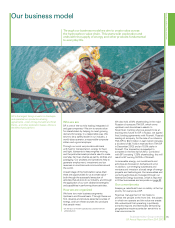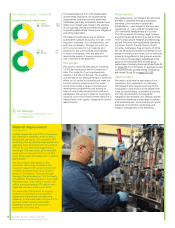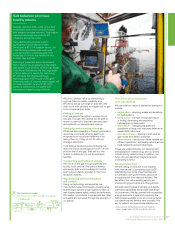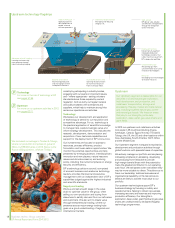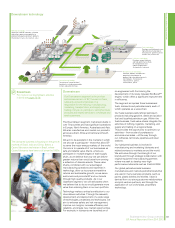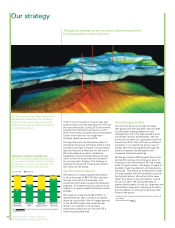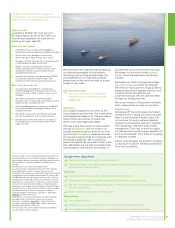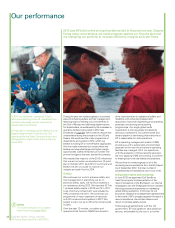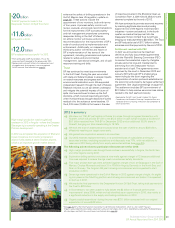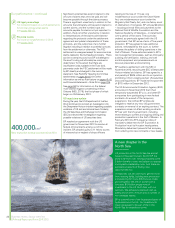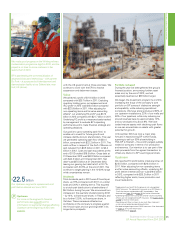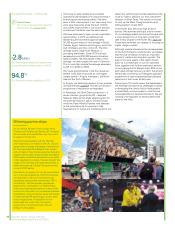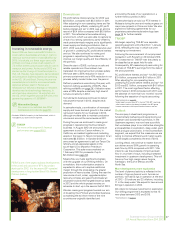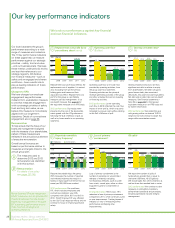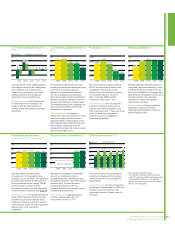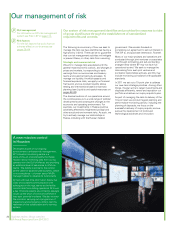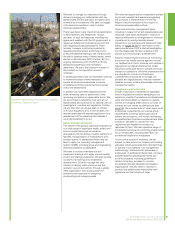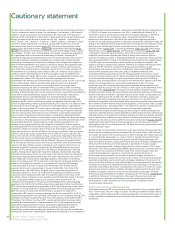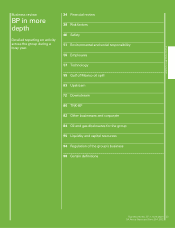BP 2012 Annual Report Download - page 25
Download and view the complete annual report
Please find page 25 of the 2012 BP annual report below. You can navigate through the pages in the report by either clicking on the pages listed below, or by using the keyword search tool below to find specific information within the annual report.
High-margin production was brought back
onstream in 2012 in Angola – where the Deepsea
Stavanger rig is currently operating at the Greater
Plutonio development.
In 2012 we completed the acquisition of Shell and
Cosan Industria e Commercio’s interests in
aviation fuels assets at seven Brazilian airports,
which is an important growth market (below).
enhance the safety of drilling operations in the
Gulf of Mexico (see US regulatory update on
page 24). These actions include the
appointment of two monitors, both with terms
of four years. A process safety monitor will
review, evaluate, and provide recommendations
for the improvement of BP’s process safety
and risk management procedures concerning
deepwater drilling in the Gulf of Mexico.
An ethics monitor will review and provide
recommendations for the improvement of BP’s
code of conduct and its implementation and
enforcement. Additionally, an independent
third-party auditor will review and report on
BP’s implementation of key terms of the
agreement, including procedures and systems
related to safety and environmental
management, operational oversight, and oil spill
response training and drills.
Trust
BP has continued to meet its commitments
to the Gulf Coast. During the year we worked
with state and federal trustees to assess impacts
on natural resources and progress early
environmental restoration work. We supported
independent research through the Gulf of Mexico
Research Initiative, so we can better understand
and mitigate the potential impacts of future oil
spills. And we continued to clean up the Gulf
shoreline, which involved responding promptly
when Hurricane Isaac brought deposits of buried
residual oil to the surface at some beaches. Of
the 4,376 miles (7,043km) that were in the area
of response covered in the Shoreline Clean-up
Completion Plana, 4,029 miles (6,484km) were
deemed complete by the end of 2012.
We have continued to promote economic recovery
by resolving legitimate claims and providing
support to two of the region’s most important
industries – tourism and seafood. In the fourth
quarter we made a final payment into the
Deepwater Horizon Oil Spill Trust fund (Trust),
bringing our total payments to $20 billion. The Trust
and BP had paid a total of $11.7 billion in claims,
advances and other payments by the end of 2012.
Settlement reached with PSC
In April we announced we had reached
definitive and fully documented agreements
with the Plaintiffs’ Steering Committee (PSC)
to resolve the substantial majority of eligible
private economic loss and medical claims
stemming from the Deepwater Horizon
accident and oil spill. The agreements were
approved by the court in December 2012 and
January 2013 although BP is challenging a
recent ruling by the court regarding the
interpretation of certain protocols established in
the economic and property damages settlement
agreement. See Legal proceedings on page 167.
The settlement includes BP’s commitment of
$2.3 billion to help resolve economic loss claims
related to the Gulf seafood industry.
$20 billion
Total BP payments made to the
Deepwater Horizon Oil Spill Trust fund.
$11.6 billion
BP’s profita in 2012.
$12.0 billion
BP’s replacement cost profita b in 2012.
a
Profit attributable to BP shareholders. This is the
measure of profit required for the group under IFRS.
b
Replacement cost profit reflects the replacement cost
of supplies and, for the group, is not a recognized
GAAP measure. See footnote b on page 34.
2012 in summary
We drew our TNK-BP partnership in Russia to a close through an agreed transaction with
Rosneft, which will provide BP with a net $12.3 billion in cash (which includes a dividend of
$0.7 billion received from TNK-BP in December 2012) and an additional 18.5% share in
Rosneft, bringing our total shareholding to 19.75%.
We took the total of asset sales announced since the start of 2010 to around $38 billion,
effectively reaching our target a year early.
We gained new exploration access in six countries.
Our 2012 reserves replacement ratio, on a combined basis of subsidiaries and equity-
accounted entities, excluding acquisitions and disposals, was 77%, with net additions to
reserves in 2012 being wholly from equity-accounted entities (see page 86).
The following points relate to particular milestones we set for 2012:
High-margin production was brought back onstream successfully in Angola, the North Sea
and other regions during 2012.
Exploration drilling activity took place at nine wells against a target of 12 because additional
time was required to ensure the rigs meet our enhanced safety standards.
Five major project start-ups were achieved (against a target of six): at Galapagos in the Gulf of
Mexico; Clochas Mavacola and block 31 in PSVM in Angola; Devenick in the North Sea; and
Skarv in Norway. The Angola LNG plant is being commissioned and is expected to start
production in 2013.
Seven rigs were operational in the Gulf of Mexico in 2012 against a target of eight. An eighth
rig is in place on the Mad Dog platform and is being commissioned and tested. It is expected
to start up in 2013.
We made the final payment to the Deepwater Horizon Oil Spill Trust, taking total payments to
the Trust to $20 billion.
In Downstream, we were unable to fully deliver the $2 billion of financial performance
improvementb since 2009, which we had identified as an opportunity in 2010, due mainly to
a significant reduction in the supply and trading contribution in 2012.
Organic capital expenditurec during the year was $23.1 billion compared with our original
expectation of around $22 billion.
b See page 75 for further information on Downstream’s performance improvement, which is a non-GAAP measure.
c
Organic capital expenditure excludes acquisitions and asset exchanges and, in 2012, expenditure associated with deepening our
US natural gas and North Sea asset bases (see footnote b on page 35).
a
Approved by the US Coast Guard’s Federal On-Scene
Coordinator, the Shoreline Clean-up Completion Plan sets
standards for the surveying, verification and completion of
clean-up activities.
Business review: Group overview
BP Annual Report and Form 20-F 2012 23
Business review: Group overview


